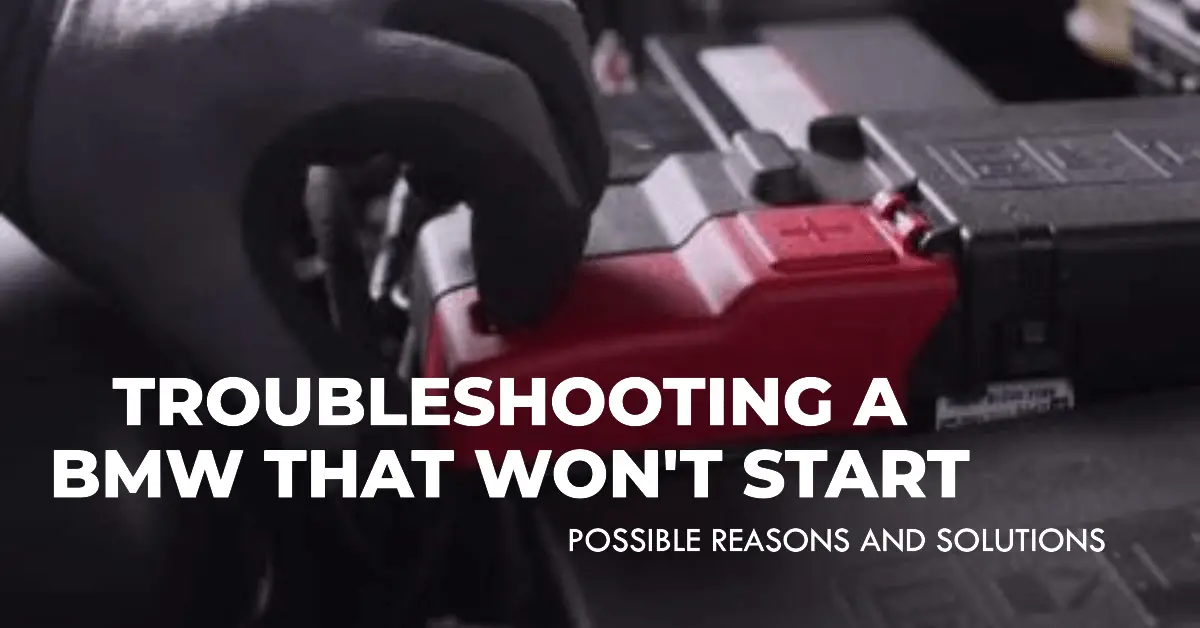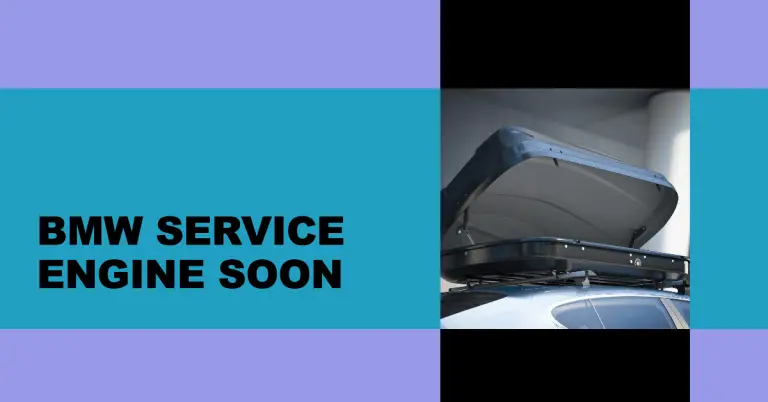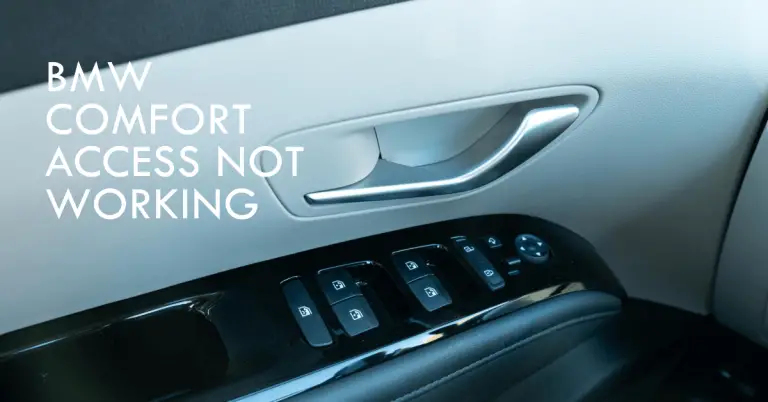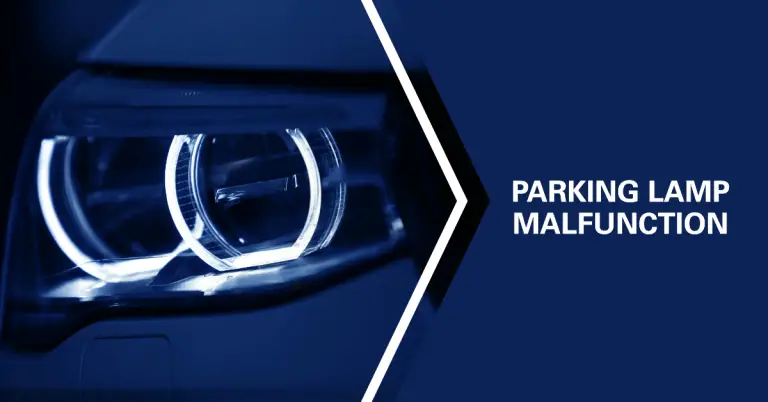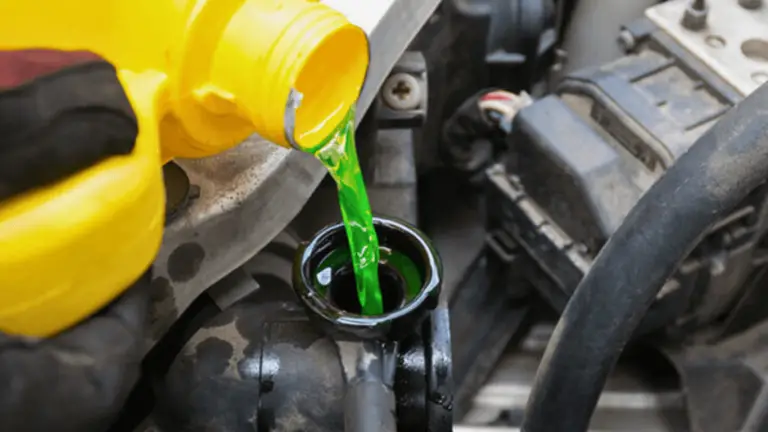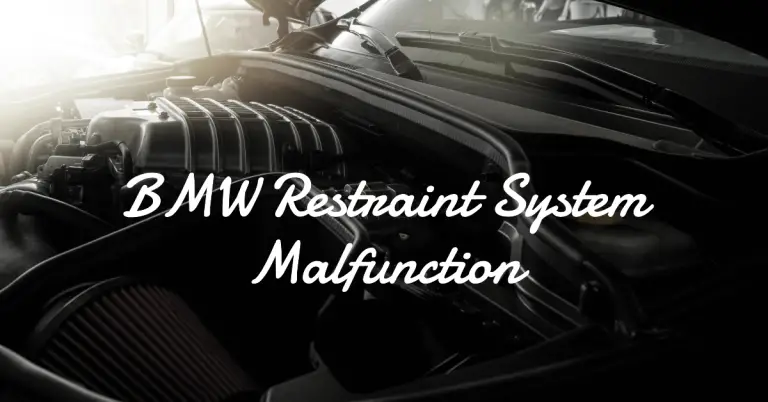BMW Won’t Start But Has Power? 12 Troubleshooting Tips to Get It Going Again
You hop in your BMW, turn the key in the ignition excited to head out for the day. But instead of the sweet sound of the engine turning over, you’re met with an awful silence punctuated only by the sad click click click of a starter that refuses to start. Your BMW won’t start, but the lights and electronics seem to have power. What’s going on and how can you diagnose and fix this frustrating no start situation?
The most common causes for a BMW that won’t start even though it has power are battery and electrical system issues, faulty fuel/ignition components, and crankshaft or camshaft sensor failure. By methodically testing different systems and components, you can isolate the root cause and take steps to get your BMW back on the road.
This comprehensive troubleshooting guide will walk you through the 12 most common reasons a BMW won’t start along with tips to test and fix each issue. We’ll cover:
- Battery, terminal, alternator, and other electrical checks
- Starter motor testing and replacement
- Potential immobilizer system problems
- Fuel pump and fuel delivery diagnostics
- Spark plugs and ignition issues
- Bad crankshaft/camshaft sensors
- and more starting system tests
Equipped with these troubleshooting steps, you can confidently diagnose your BMW’s no start problem. Let’s dive in and get your car started!
#1: Check Battery Terminals, Voltage, and Alternator
The electrical system is the first place to start diagnosing a no start problem since without adequate battery power the starter won’t have enough juice to turn over the engine. Focus first on the battery itself before moving to the terminals, alternator, and other electrical components.
Inspect Battery Terminals and Cables
Make sure the battery terminals are clean and tight. Corrosion and loose connections can prevent sufficient power from reaching the starter. Use a wire brush to scrub away any build-up on the battery posts and cable connectors. Tighten down the connections with a wrench and look for any cracked or damaged cables that need replacement.
Test Battery Voltage
Use a multimeter to test the battery’s state of charge. Turn off any accessories, switch the multimeter to DC voltage mode, and attach the positive lead to the battery’s positive post and negative lead to the negative post. A properly charged BMW battery should have a voltage of around 12.6 volts. Any lower could indicate a dead battery in need of a recharge or replacement.
Check Alternator Output
If the battery checks out, test the alternator’s output voltage to see if it’s providing proper charging to the battery. With the engine running at 1500 rpm, measure the voltage between the positive and negative posts again. A good alternator will output around 13.5 – 15 volts. If your alternator voltage reading is too low, it cannot adequately charge the battery while driving and will need replacement.
Catching battery or alternator issues now can save you from being stranded with a fully dead battery later on. Replace worn components and maintain proper electrical connections to ensure your BMW has the power to start every time.
#2: Diagnose and Replace Faulty Starter Motor
The starter motor is responsible for spinning the engine over so it can ignite and start. Failures here will directly cause a no start condition. Here’s how to test your BMW’s starter:
Tap Starter with Hammer
A simple starter test is to tap it lightly with a hammer or rubber mallet while someone tries to start the car. Sometimes the impact can jolt a stuck starter into action. If the BMW fires up, the starter is likely failing and should be replaced soon.
Listen for Clicking
Turn the key and listen closely for any clicking coming from the starter motor. Clicking indicates the starter solenoid is still working and getting voltage, but the motor itself can’t turn over likely due to a lack of battery power. Recharge or replace the battery first before replacing the starter.
Check Starter Current Draw
Use a multimeter to measure current draw on the starter circuit while cranking. Current draw should be well within the starter’s specifications. Too little current could mean resistance in the circuit, while too much indicates a short and faulty starter that needs replacement. Consult repair manuals for your BMW’s specific starter current specs.
By testing the starter motor and listening for evidence of operation, you can determine if this key component needs attention to get your BMW running again. Starters do eventually wear out and should be replaced every 100-150k miles to avoid being left with a no start situation.
#3: Look for Shorts and Damage in Electrical Wires
Damaged or deteriorated wiring preventing proper electrical signals can cause all sorts of starting trouble. Give your BMW’s wiring harness, cables, and connections a thorough inspection to spot any issues.
Inspect Wire Harness & Connectors
Visually inspect the wire harness leading to the starter, battery, and engine bay for any cracked or damaged insulation. Also look for loose, heavily corroded, or burnt connectors that may be interrupting power flow. Wiggle the wires while trying to start the car to see if that causes any change.
Check Ground Cables
The ground cables that tie the engine block and battery to the chassis are just as important for completing the electrical circuit. Check that the battery’s negative ground wire is securely fastened to bare metal and free of rust/debris.
Use a Multimeter to Test Circuits
Using a digital multimeter, you can measure resistance in starter and charging circuits to isolate faults. Reference a wiring diagram to know the normal resistance values for each circuit branch. Infinite resistance points to breaks, while low resistance indicates shorts.
Electrical issues can be tricky to track down. Patience and thorough testing of all wires, harnesses, and connections can help uncover and prevent recurring starting problems.
#4: Rule Out Immobilizer System Problems
BMW’s immobilizer system prevents the engine from starting unless the proper transponder key is used. Issues with the key, receiver coil, or programming may prevent the system from properly authorizing the engine to start.
Try Spare Keys & Check Key Battery
Make sure you aren’t using an old key that was removed from the immobilizer programming. Transponder chips can also fail over time. Try your spare keys to rule out a bad key. And replace the key fob battery if it’s dead.
Check/Reset Immobilizer Components
If the keys are ok, you may need to reset or reconnect immobilizer components like the receiver coil, emulator, and transmission modules. Consult factory repair procedures for properly synchronizing and registering new key codes.
Program New Keys
In rare cases, you may need to program completely new keys and ignition locks into the immobilizer system, which requires specialized BMW diagnostic software and coding procedures. Work with a professional BMW technician for this job.
Ensuring your BMW’s immobilizer components recognize the key code is essential to getting the engine to turn over and start.
#5: Inspect Engine and Body Grounds
Poor grounding prevents the engine from receiving the full electrical current it needs to start. The engine bay contains several ground points that tie the engine and body to the negative battery terminal.
Inspect Condition of Ground Straps/Cables
Look for loose ground fasteners or corroded/damaged ground straps, especially where the body and engine block meet. All ground points should be cleaned to bare metal and re-tightened using a wire brush and wrench.
Check Resistance with Multimeter
Use a multimeter to check continuity between ground points and the negative battery terminal. Resistance should be as close to 0 ohms as possible. Higher resistance means the ground needs to be re-established.
Proper grounding may not seem as exciting as other electrical issues, but is equally important for delivering the voltage needed to crank and start the motor.
#6: Test the Fuel Pump and Pressure
The fuel pump’s job is to deliver pressurized gasoline from the tank to the fuel injectors for engine combustion. Weak pumps that fail to prime or provide sufficient fuel pressure will lead to a no start.
Listen for Fuel Pump Prime
Turn the key to the ON position and listen near the fuel tank for the distinctive whirring sound of the in-tank fuel pump running for a few seconds to build pressure. No noise could indicate pump failure or a tripped fuel pump relay.
Check Fuel Pressure at Fuel Rail
Use a fuel pressure gauge to test fuel system pressure. Attach the gauge port to the Schrader valve on the fuel rail and turn the key to build pressure. Pressure should quickly climb to around 40-60 psi. Low pressure points to a bad pump unable to maintain fuel delivery.
Inspect Pump and Strainer
If fuel pressure is low and the pump isn’t priming, the entire pump assembly may need replacement. Check for a clogged pump strainer and inspect pump operation. Consult BMW service manuals for approved pump specifications.
Don’t let a faulty fuel pump leave you sitting at the gas station waiting for a tow. Proactively test its operation and replace if needed.
#7: Diagnose Spark Plug and Ignition Problems
In order for combustion to take place, the engine needs a strong spark at the right time from the ignition system and spark plugs. Weak ignition components can cause intermittent no starts.
Inspect Spark Plug Condition
Remove the spark plugs and check their condition. Look for excessively worn electrodes, heavy deposits of carbon/fuel, cracks in the insulator, or improper gap spacing. Worn plugs won’t ignite properly. Re-gap or replace plugs every 50-60k miles.
Test Ignition Coil Packs
Measure ignition coil primary and secondary resistance with a multimeter and compare to BMW repair manual specs. Swap coils with a known good cylinder to test. Faulty coils will misfire and cause rough running or no starts.
Ensure Good Spark Plug Wire Connections
Make sure the plug wire boots securely snap onto the spark plug’s top terminal. Loose connections can prevent firing spark. Also check for cracking/damage in the plug wires themselves.
Give your engine the strong precise spark needed for starting by keeping plugs, wires, and ignition coils in optimum condition.
#8: Troubleshoot Crankshaft and Camshaft Position Sensors
The crankshaft (CKP) and camshaft (CMP) sensors are key position monitors used to control fuel injection and ignition timing for starting the engine and smooth running. Failure triggers a no start.
Unplug Sensors and Check Resistance
Remove the electrical connectors from the CKP and CMP sensors. Use a multimeter on the Ohms setting to measure sensor resistance terminals. Compare to factory values to see if out of spec.
Look for Sensor Damage or Debris
Inspect sensors for damage cracks, leaks, stuck bearings, or built up debris which can obstruct their position reading. Sensors are usually located behind each camshaft under valve cover.
Review Codes for Sensor Failure
When the CKP or CMP fail, it usually sets a specific trouble code pointing to that sensor. Reading engine codes via the OBD-II scanner can provide insight into these crank/cam sensor issues.
The CKP and CMP provide essential position input for controlling engine operation. Their failure leads to hesitation, stalling, and no starts.
#9: Check the Condition of Fuel Injectors
Fuel injectors precisely spray fuel into the intake ports to mix with air entering the combustion chamber. Faulty injectors that leak fuel or become clogged with deposits will prevent proper engine running and starting.
Listen for Abnormalities
With the engine cover removed, have someone crank the starter while you listen near the fuel injectors. You should hear the injectors clicking open and closed in sequence. Uneven or missing clicking can pinpoint bad injectors.
Test Injector Resistance
Use a multimeter to measure the resistance across an injector’s two terminals. Compare the reading to factory specs. Significantly higher resistance means the injector is clogged or damaged internally.
Consider Professional Cleaning/Flow Testing
To thoroughly test injector condition and performance, they should be professionally flow tested on a special machine. Many shops offer injector cleaning and ultrasonic services to improve flow and reduce deposits.
Keeping your BMW’s finely tuned fuel injection system in top shape is key for smooth daily operation. Don’t hesitate to inspect and service the injectors when trouble arises.
#10: Fix Intake or Vacuum Leaks Effecting Engine Operation
Even the smallest intake or vacuum leak can impact the air fuel mixture and prevent an engine from starting properly. Listen and look closely for hissing air leaks in the intake and vacuum system.
Spray Suspect Areas with Carb Cleaner
Use carburetor or brake cleaner spray on vacuum hoses, intake gaskets, and intake piping while the engine is running. If the engine RPM changes when spraying a spot, that indicates a vacuum leak.
Inspect hoses for Cracks or Damage
Carefully examine all rubber vacuum hoses for any cracks, holes, or deterioration that can allow air to leak into system. Check where hoses connect for loose clamps.
Check Intake Gaskets and Seals
Make sure the intake manifold, throttle body, mass airflow sensor, and other hard connections are properly sealed. Failed gaskets here can introduce leaks. Consult service manual torque specs and procedures.
Even small vacuum leaks throw off the engine’s fine tune and rob power. Repairing them restores performance including smooth starts.
#11: Clean or Replace Dirty/Clogged Fuel Filter
A restricted fuel filter chokes off the fuel supply to the injectors and engine causing hard starting and stalling. If your filter hasn’t been serviced in a while, dirty fuel could be the culprit.
Check Condition of Fuel Filter
Remove the fuel filter from its housing. Inspect for dirt build up and debris clogging the filter element. Also look for corrosion and rust inside the filter housing itself.
Note Intervals for Replacement
Consult BMW’s maintenance schedule to see when your filter needs to be changed. Most models recommend replacement every 50,000 miles or so, more often if you use low quality fuel.
Prevent Debris from Entering Tank
When adding fuel, use a funnel with a fine mesh screen to filter out dirt and particles that can clog the filter. Keep the gas cap sealed tight to avoid debris entering the tank.
Fresh fuel and a clean filter are essential for the high pressure BMW fuel injection system to operate at peak performance.
#12: Ensure There is Sufficient Engine Oil
Oil keeps your BMW’s internals lubricated, cooled, and protected at startup. An engine too low on oil can seize and fail to start. Check levels and condition regularly.
Check Dipstick for Proper Oil Level
With the engine off and car parked on level ground, pull the oil dipstick and wipe clean with a rag. Reinsert fully and remove again to check level on indicator. Oil should be within minimum and maximum marks.
Look for Leaks Underneath Vehicle
Inspect ground where BMW is parked for any fresh oil leaks or stains. Leaks indicate possible cracks/damage in oil pan, gaskets, seals, or engine housing. Have leaks addressed immediately.
Change Oil and Filter per Maintenance Schedule
Follow the BMW recommended oil service intervals, usually around 10,000 miles. Use specified viscosity, rating, and certifications marked in your owner’s manual.
Keeping clean premium oil at the right level reduces wear and prevents dry starts. Make oil changes a priority for engine longevity.
Get Your BMW Back On The Road
Difficult starting or no start conditions can definitely be frustrating. But armed with this comprehensive troubleshooting guide, you now have the knowledge to methodically test and pinpoint the most common underlying causes.
Whether it ends up being a simple loose battery cable or faulty starter motor, you can isolate issues one-by-one until hitting the root cause. Then take appropriate action to replace or repair components and get your BMW running smoothly again. Investing in some basic tools like a multimeter and OBD scan tool provides the diagnostics you need for electrical and fuel system testing during troubleshooting.
Has your BMW left you stranded due to a mysterious no start before? Share your experiences troubleshooting and finally figuring out the problem. Knowing the most common causes ahead of time gives you a leg up for outsmarting and solving difficult no start issues. Here’s to reliable starts and happy motoring in your BMW for miles to come!

